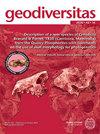Pseudodrobna natator n. comb., a new link between crustacean faunas from the Jurassic of Germany and Cretaceous of Lebanon
IF 1.2
3区 地球科学
Q2 PALEONTOLOGY
引用次数: 0
Abstract
ABSTRACT Dendrobranchiate shrimps are abundant in Fossil-Lagerstätten (where fossils are exceptionally preserved). Despite their preservation, classifying them can be challenging as most diagnostic characters are based upon extant species. Penaeus natator Glaessner, 1945 (Late Cretaceous, Lebanon, Sahel Alma), is one of those cases in which the systematic assignment of the species can be difficult. It was assigned by “default” to Penaeus Fabricius, 1798, before being moved to Metapenaeopsis Bouvier, 1905. The recent description of Pseudodrobna kenngotti Winkler, 2017 (Late Jurassic, Germany, Schernfeld, a Solnhofen-type Fossil-Lagerstätte) shows that Penaeus natator should be assigned to Pseudodrobna Winkler, 2017. This attests once again the similarity in composition of crustacean faunas between Late Jurassic Solnhofen-type Fossil-Lagerstätten and the Late Cretaceous Fossil-Lagerstätten of Lebanon. We also discuss the palaeoecological significance of bilobed eyes, which occur in three species from the Late Cretaceous of Sahel Alma: Pseudodrobna natator n. comb., Palaeobenthonectes arambourgi (Roger, 1946) and Palaeobenthesicymus libanensis (Brocchi, 1875). These eyes seem to have evolved convergently due to the deep-water and dim-light palaeoenvironment of these three shrimp species.浮游拟drobna。,德国侏罗纪和黎巴嫩白垩纪甲壳类动物群之间的新联系
摘要:树枝状虾在化石湖(化石保存异常完好)中数量丰富。尽管它们被保存了下来,但对它们进行分类可能很有挑战性,因为大多数诊断特征都是基于现存物种。Penaeus natator Glassner,1945年(晚白垩世,黎巴嫩,萨赫勒-阿尔玛),是物种系统分配可能很困难的案例之一。1798年,它被“默认”分配给了Penaeus Fabricius,1905年被转移到Metapenaeopsis Bouvier。最近对Pseudodrobna kenngotti Winkler的描述,2017(晚侏罗纪,德国,Schernfeld,一种索伦霍芬型化石Lagerstätte)表明,游泳对虾应归属于Pseudotrobna Winkler,2017。这再次证明了晚侏罗纪Solnhofen型化石Lagerstätten和晚白垩世黎巴嫩化石Lagerssättene在甲壳类动物组成上的相似性。我们还讨论了双叶眼的古生态意义,双叶眼出现在萨赫勒-阿尔玛晚白垩世的三个物种中:Pseudodrobna natator n.comb。,Aramborgi古本通线虫(Roger,1946)和libanensis古本通虫(Brocchi,1875)。由于这三种虾的深水和昏暗的古环境,这些眼睛似乎是趋同进化的。
本文章由计算机程序翻译,如有差异,请以英文原文为准。
求助全文
约1分钟内获得全文
求助全文
来源期刊

Geodiversitas
地学-古生物学
CiteScore
3.00
自引率
5.60%
发文量
31
审稿时长
>12 weeks
期刊介绍:
Geodiversitas is a fully electronic journal, with a continuous publication stream, devoted to varied aspects of Earth Sciences. It publishes original results particularly on systematics, phylogeny, paleobiodiversity and paleoenvironment.
Thematic issues may also be published under the responsibility of a guest editor.
 求助内容:
求助内容: 应助结果提醒方式:
应助结果提醒方式:


